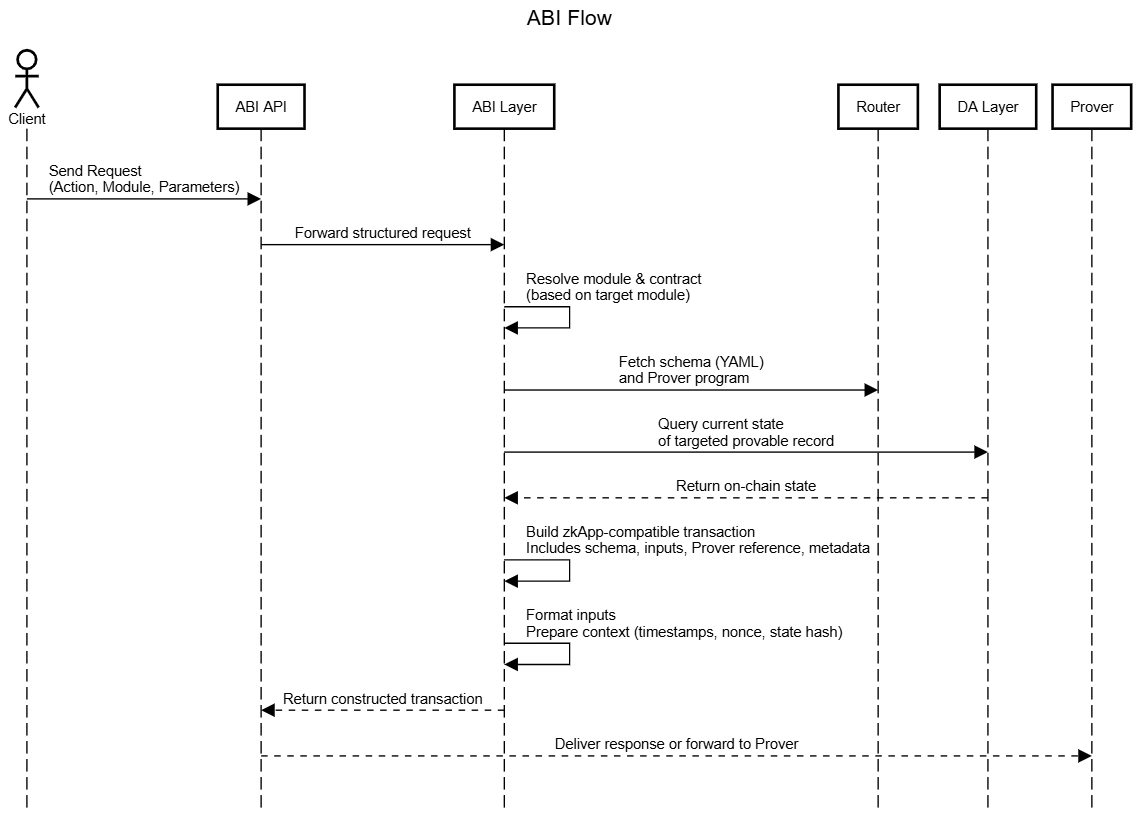ABI
Overview
In Silvana, the Application Binary Interface (ABI) is a system-level service that builds transactions using module contracts and requested parameters.
The ABI API exposes this capability to external systems and developers. It allows clients to send intent-based requests (e.g., "deploy token"), which ABI transforms into fully constructed transactions that are ready for proof generation and blockchain submission.
The ABI does not execute or submit transactions. Instead, it acts as a transaction constructor, taking abstract instructions and transforming them into valid zkApp-compatible transaction payloads.
ABI Responsibilities
The ABI is responsible for:
- Resolving the correct smart contract from a requested module
- Building a transaction object based on frontend inputs and module definitions
- Formatting the transaction in accordance with ZK-friendly standards (compatible with Prover Program)
- Passing the built transaction to other components (e.g., Prover, Tx Sender)
It serves as the glue between high-level API calls and the underlying module implementations.
“API sends the request, ABI builds the transaction”.
Purpose and Usage
The ABI in Silvana is implemented as a modular, server-side component that can be accessed via a REST interface. It is designed to be agnostic to execution environments and pluggable into any Silvana-compatible module or external service.
It acts as the transaction construction gateway - receiving intent from clients and building fully structured, ZK-compatible transactions.
Workflow
- Request Intake
A request from the frontend or external client is sent via API. It includes:
-
Action type (
create,transfer, etc.) -
Target module (
fungible-token,marketplace, etc.) -
Parameters (
token_ID,recipient, etc.)
- API → ABI Forwarding
API forwards the structured request to ABI. API does not interpret business logic.
- Module and Contract Resolution
ABI identifies the relevant contract interface and logic from the specified module.
- Schema and Prover Program Retrieval
ABI fetches the schema (YAML-based) and links to the Prover Program via the Router. This defines allowed transitions and input types.
- State Verification via DA Layer
ABI queries the Data Availability layer to fetch the current state of the targeted provable record. It checks consistency with on-chain state.
- Transaction Construction
ABI builds a zkApp-compatible transaction:
-
Includes schema, inputs, metadata, and Prover Program reference
-
Formats inputs for the Prover
-
Prepares transaction context (timestamps, nonce, record state hash)
- Transaction Return
The built transaction is returned to the API or passed to the next layer (Prover). ABI’s role ends here.
See how ABI flow looks like:

Example
This example constructs a transaction to deploy a new fungible token in JSON:
{
"module": "fungible-token",
"action": "create",
"params": {
"name": "GoldUSD",
"symbol": "GUSD",
"decimals": 2,
"initialSupply": "1000000",
"owner": "0xA1B2C3D4E5F6G7H8"
},
"meta": {
"timestamp": "2025-04-17T10:45:00Z",
"network": "testnet",
"ProverProgram": "ft_create_v1"
}
}
Explanation of Fields:
-
module: Target logic module (must be registered in Silvana Core) -
action: Requested operation within the module -
params: Action-specific inputs, matched against the contract interface -
meta: Optional context metadata-
timestamp: Client-side request time (used in transaction context) -
network: Network ID or alias -
ProverProgram: Optional ProverProgram version or identifier to resolve
-
Output:
ABI produces a complete transaction object ready for:
-
Zk-proof generation (by Prover)
-
Blockchain submission (by Tx Sender)
Additional Features
-
Works across modules using standard interfaces
-
Uses contract metadata but does not execute it
-
Supports plugins for ABI Explorer interfaces
-
Used in PXE, CXE, and TEE environments